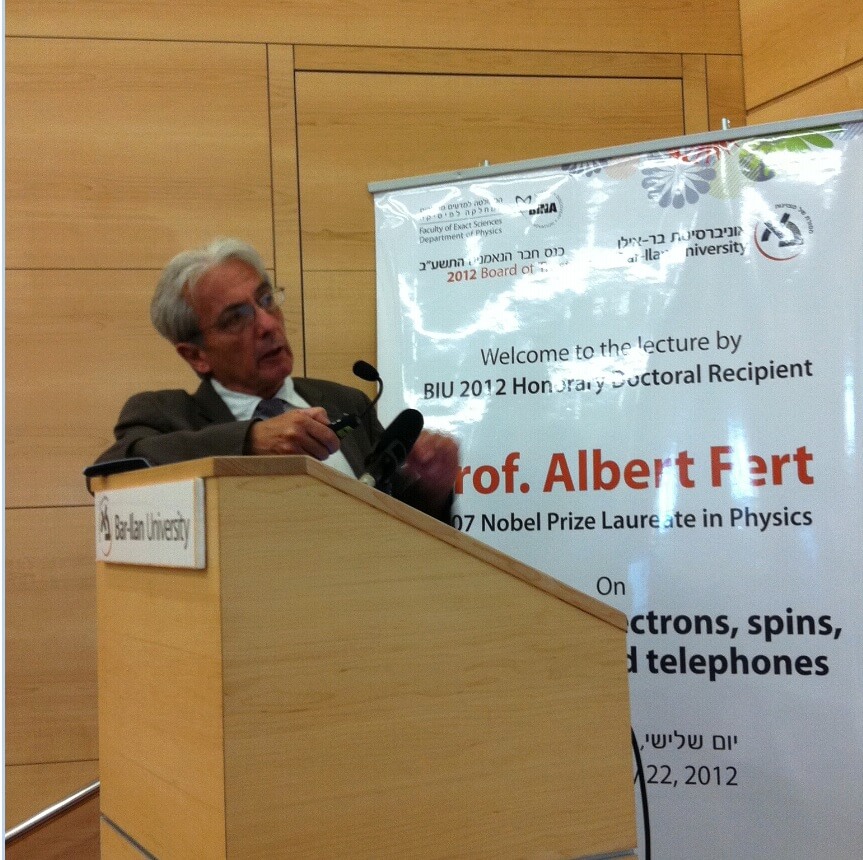This is what Prof. Albert Perth - winner of the 2007 Nobel Prize in Physics for the discovery of the GMR - a huge variation of the electrical resistance through the activation of a magnetic field (Giant Magnetoresistance) and recipient of an honorary doctor's degree promises

* The article was published on the science channel of Bar-Ilan University and "Haaretz"
The combination of spintronics - the scientific field whose foundation Prof. Albert Pert from France won the Nobel Prize in Physics jointly with his colleague Peter Grunberg from Germany - together with nanotechnology and in particular graphene sheets and carbon nanotubes, will move the world forward and enable the continued improvement of electronics at the rate dictated by Moore's Law as well After the current silicon-based technology will reach the end of its life and encounter physical limitations.
This is what Prof. Pert promises in the lecture he gave on the occasion of his winning an honorary doctorate at Bar-Ilan University, which was held at the Nanotechnology Center on Tuesday this week.
Five years ago Prof. Albert Fert won the Nobel Prize in Physics for the discovery of the GMR - a huge change in electrical resistance through the activation of a magnetic field (Giant Magnetoresistance) and this is his third visit to Israel. On his first visit, he participated in a conference in honor of Prof. Yossi Yeshuron from Bar-Ilan, and among its organizers was Prof. Lior Klein (both from the Physics Department of the Faculty of Exact Sciences at Bar-Ilan University) and he also received the prestigious Wolf Prize, considered by many to be the forerunner of the Nobel Prize. His second visit was for a conference which was organized together by Prof. Lior Klein.
This time, on his third visit, it was Prof. Klein together with Prof. Benny Arenberg, the vice president who introduced Prof. Pert who was awarded an honorary doctorate by Bar-Ilan University. Prof. Pert currently serves as the Scientific Director of the Combined CNRS/Thales Physics Unit in Orsay, France, as well as an Adjunct Professor of Physics at the University of Michigan.
In his lecture Prof. Pert explains: "The science of spintronics is defined as a new type of electronics that uses not only the charge of the electron but also its magnetism - the spin. The first effect discovered in the field was GIANT MAGENTORESISTENCE which is used today to read the hard disk of computers. Thanks to magnetic sensors based on this discovery that are sensitive to small magnetic fields, it was possible to increase the capacity of the disks a thousand times or more, because they allowed the writing and reading of bits of small physical size, thanks to the precision.
But this was only the beginning of the revolution. There are many effects that can be used. The next application is M-RAM magnetic memories that will replace the RAM in the computer. These memories are both fast and are saved when the computer is turned off - that is, they are non-volatile memories.
The volatile fast memories consume energy so they won't be erased. It turns out that energy consumption in server rooms is responsible for 7% of all energy consumption in the economy, therefore moving to memories that do not consume energy can make a significant contribution to the economy's overall energy savings. Moving to a new M-RAM method based on spintronics will make it possible to create fast memories that are non-volatile and therefore do not require a disk backup and a permanent connection to electricity. Already today we see examples of the use of such memories for example in chips next to the processors.
Other applications of spintronics are in the creation of new sources for high-frequency frequency generators that can be used in the field of communication, in the creation of hybrid systems that will combine spintronic components with conventional electronics, and at a later stage even in the creation of quantum computers that will be orders of magnitude faster than today's computers. According to Prof. Pert, these technology exchanges are inevitable, because the ability to comply with Moore's Law - the unofficial law that states that the power of processors doubles every year and a half for a given price - will not be able to exist forever.
Silicon technology is getting closer to the end of its journey, in ten years at most the chip companies will encounter an impenetrable wall - the laws of physics will not allow the components in the chip to be reduced even further. Today the smallest nodes in chips are 28 nm in diameter. 'Hybrid' solutions where some components are based on spintronics and some are still based on electronics could help the industry to pull a few more years, no more.
According to him, the next generation will be the application of spintronics principles together with nanotechnology developments and in particular graphene and carbon nanotubes. It is still difficult to assess the power of this revolution because this technology is in its infancy. Only a small taste of it was given by Samsung when it announced displays based on nano carbon tubes. One of the limitations to the use of graphene stems from the fact that it is difficult to produce on a mass scale, but he estimates that until it is necessary to replace silicon, a way will also be found to produce graphene sheets cheaply.

5 תגובות
"small junctions" and not "small junctions"
Fascinating article!
Interesting, clear and enriching!
Thank you very much my father 🙂
This node is male